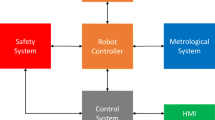Abstract
An approach for solving the challenges that arise from the increased complexity of modern assembly tasks is believed to be human robot co-operation. In these hybrid workplaces humans and robots do not only work on the same task or interact during certain assembly steps, but also have overlapping workspaces. Therefore, ‘safe robots’ should be developed that do not harm workers in case of a collision. In this chapter, an overview of methods for designing a hardware based soft robot that is inherently safe in human-machine interaction is given. Recent projects show that robots could be soft enough for interaction but they are not able to resist forces that occur in the assembly process. Current solutions show that the designer of such robots must face a trade-off between softness and dexterity on the one hand and rigidity and load carrying capabilities on the other hand. A promising approach is to integrate variable stiffness elements in the robotic system. The chapter classifies two main design rules to achieve stiffness variability, the tuning of material properties and geometric parameters. Existing solutions are described and four concepts are presented to show how different mechanisms and materials could be combined to design safe assembly robots with a variable stiffness structure.
Access this chapter
Tax calculation will be finalised at checkout
Purchases are for personal use only
Preview
Unable to display preview. Download preview PDF.
Similar content being viewed by others
References
Trivedi D, Rahn C, Kier W, et al. (2008) Soft robotics: Biological inspiration, state of the art, and future research. Appl. Bionics and Biomechanics 5(3): 99–117
Kim S, Laschi C, Trimmer B (2013) Soft robotics: a bioinspired evolutions in robotics. Trends in Biotechnology 31(5):287–294
Bischoff R, Kurth J, Schreiber G, et al (2010) The KUKA-DLR Lightweight Robot arm - a new reference platform for robotics research and manufacturing. 41st Robotics (ISR) and 6th German Conf. on Robotics (ROBOTIK): 1–8.
Matthias B, Kock S, Jerregard H, et al. (2011) Safety of Collaborative Industrial Robots. IEEE Int. Symp. on Assembly and Manufacturing (ISAM): 1–6
Rolf M, Steil J (2012) Constant curvature continuum kinematics as fast approximate model for the Bionic Handling Assistant. IEEE /RSJ Int. Conf. on Intelligent Robots and Systems: 3440–3446
Seok S, Onal C, Cho K, Wood R (2012) Meshworm: A Peristaltic Soft Robot with An-tagonistic Nickel Titanium Coil Actuators. IEEE/ASME Transactions on Mechatronics: 1485–1497
Kang R, Branson D, Zheng T, et al. (2013) Design, modeling and control of a pneumati-cally actuated manipulator inspired by biological continuum structures. Bioinspiration & Biometrics 8(3)
Ranzani T, Cianchetti M, Gerboni G, et al. (2013) A modular soft manipulator with vari-able stiffness. 3rd Joint Workshop on New Technologies for Computer/Robot Assisted Surgery
Cheng N, Lobovsky M, Keating S, et al. (2012) Design and Analysis of a Robust, Low cost, Highly Articulated Manipulator Enabled by Jamming of Granular Media. IEEE Int. Conf. on Robotics and Automation: 4328–4333
Majidi C (2013) Soft Robotics: A Perspective – Current Trends and Prospects for the Fu-ture. Soft Robotics 1(1):5–11
Kim Y, Cheng S, Kim S, Iagnemma K (2013) A Novel Layer Jamming Mechanism With Tunable Stiffness Capability for Minimally Invasive Surgery. IEEE Transactions on Ro-botics 29(4): 1031–1042
Schmitt J, Last P, Löchte C, Raatz A (2009) TRoBS – A Biological Inspired Robot. IEEE Int. Conf. on Robotics and Biomimetics: 51–56
Follmer S, Leithinger D, Olwal A, et al. (2012) Jamming User Interfaces: Programmable Particle Stiffness and Sensing for Malleable and Shape-Changing Devices. 25th ACM Symp.on User interface software and technology: 519–528
Taniguchi H, Miyake M, Suzumori K (2010) Development of New Soft Actuator Using Magnetic Intelligent Fluids for Flexible Walking Robot. Int. Conf. on Control, Automa-tion and Systems, Oct., 2010: 1797–1801
Majidi C, Wood R J (2010) Tunable elastic stiffness with microconfined magnetorheo-logical domains at low magnetic field. Applied Physics Letters 97: 164104-1-164104-4
Calvert P (2009) Hydrogels for Soft Machines. Adv. Materials 21: 743–756
Haraguchi K (2007) Nanocomposite hydrogels. Current Opinion in Solid State Materials and Science 11:47–54
Loizou E, Butler P, Porcar L, et al. (2006) Dynamic Responses in Nanocomposite Hy-drogels. Macromolecules 39:1614–1619
Löchte C, Kunz H, Schnurr R, Dietrich F, Raatz A, Dilger K, Dröder K. (2013) Form-Flexible Handling Technology for Automated Preforming. 19th Int. Conf. on Composite Materials (ICCM), Montreal, Canada, e-proc
Takashima K, Noritsugu T, Rossiter J, et al. (2011). Development of Curved Type Pneu-matic Artificial Rubber Muscle Using Shape-memory Polymer. SICE Annual Confer-ence, Tokyo, Japan: 1691–1695
Rogers J A (2013) A Clear Advance in Soft Actuators. Material Science 341:968–969
Hu T M, Park Y-J, Cho K-J (2012) Design and Analysis of a Stiffness Adjustable Struc-ture Using an Endoskeleton. Precision Engineering and Manufacturing 13(7): 1255–1258
Mc Knight G P Henry C P (2010) Deformable variable-stiffness cellular structures. US Patent 7,678,440
Hayashibara Y (2008) Study on Variable Stiffness Mechanism Using Wire Spring. Ro-botics and Mechatronics 20(2): 296-301
Galloway K C, Clark J E, Koditschek D E (2009) Design of a tunable stiffness composite leg for dynamic locomotion. Proc. of IDETC/CIE 2009: 1-8
Zuo S, Iijima K, Tokumiya T, Masamune K (2013) Variable stiffness outer sheath with “Dragon skin” structure and negative pneumatic shape-locking mechanism. Computer Assisted Radiology and Surgery 2014: 1-9
Vos R, Barret R, Romkes A (2011) Mechanics of pressure-adaptive honeycomb. Intelli-gent Material Systems and Structures 22(10): 1041-1055
Shan Y, Lotfi A, Philen M (2008) Fluidic Flexible Matrix Composites for Autonomous Structural Tailoring. Proc. of SPIE 6525: 652517-1-652517-14
Shepherd et al. (2011) Multigait soft robots. Proc. of the National Academy of Science 108(51):20400-20403
Author information
Authors and Affiliations
Editor information
Editors and Affiliations
Rights and permissions
Copyright information
© 2015 Springer-Verlag Berlin Heidelberg
About this paper
Cite this paper
Raatz, A., Blankemeyer, S., Runge, G., Bruns, C., Borchert, G. (2015). Opportunities and Challenges for the Design of Inherently Safe Robots. In: Verl, A., Albu-Schäffer, A., Brock, O., Raatz, A. (eds) Soft Robotics. Springer, Berlin, Heidelberg. https://doi.org/10.1007/978-3-662-44506-8_15
Download citation
DOI: https://doi.org/10.1007/978-3-662-44506-8_15
Published:
Publisher Name: Springer, Berlin, Heidelberg
Print ISBN: 978-3-662-44505-1
Online ISBN: 978-3-662-44506-8
eBook Packages: EngineeringEngineering (R0)




